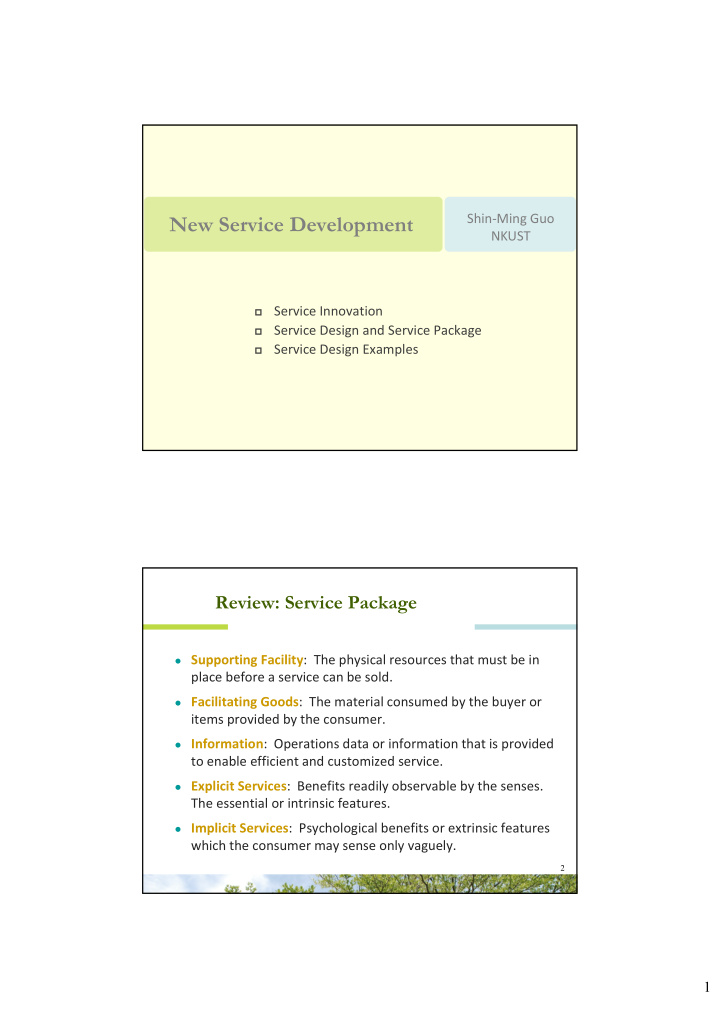



New Service Development Shin‐Ming Guo NKUST Service Innovation Service Design and Service Package Service Design Examples Review: Service Package Supporting Facility : The physical resources that must be in place before a service can be sold. Facilitating Goods : The material consumed by the buyer or items provided by the consumer. Information : Operations data or information that is provided to enable efficient and customized service. Explicit Services : Benefits readily observable by the senses. The essential or intrinsic features. Implicit Services : Psychological benefits or extrinsic features which the consumer may sense only vaguely. 2 1
I. Innovation in Services Idea Generation: Customers, Employees, Competitors, Technology Basic Research : Pursue a planned search for new knowledge regardless of possible application. (number theory) Applied Research : Apply existing knowledge to problems in creation of new service. (security coding) Development : Apply knowledge to problems to improve a current service. (on‐line shopping) 3 Technology-Driven Service Innovations Source of Service Example Service Industry Impact Technology Power/energy Jet aircraft International flight is feasible Electric vehicles Battery charging/exchange Facility design Hotel atrium Feeling of grandeur/spaciousness Enclosed stadium Year‐around use Digital camera Photo printing/Tourism Materials Synthetic engine oil Fewer oil changes Just‐in‐time (JIT) Reduce supply‐chain inventories Methods Da Vinci surgery Surgeons and quality improvement Information e‐commerce Increase market to world‐wide Internet Video on demand 4 2
Case Study: Car Sharing Best suited to urban locations where there was a dense base of potential users, parking was https://www.youtube.com/watch?v=cX 2xJOo5LIs expensive, and the need to drive was limited. Big hole in the rental market: short‐term, on‐demand private car access. 3
Information Technology for Car Sharing • Mobile technology enables vehicle reservation and usage. • Wireless transmission authorizes users, read odometer, mileages, and time stamps. Challenges for Service Innovation Limited ability to protect intellectual properties. Definition of the intangibles. Incremental nature of innovations. Limited ability to build prototypes or conduct tests 8 4
II. Service Design location, Customer interior design Supporting Facility Participation service blueprint, Facilitating Goods service recovery Simultaneity Information revenue Perishability management Explicit Services Intangibility Implicit Services service encounter Heterogeneity capacity planning, waiting line management Service Design Elements Design Elements Topics Structural Delivery system Process structure , service blueprint, strategic positioning Facility design Servicescapes, architecture, process flows, layout Location Geographic demand, site selection, location strategy Capacity planning Strategic role, queuing models, planning criteria Managerial Information Technology, scalability, use of Internet Quality Measurement, design quality, recovery, tools, six‐sigma Service encounter Encounter triad, culture, supply relationships, outsourcing Managing capacity Strategies, yield management, queue management & demand 10 5
Facility Design: Shouldice Hospital Service Package for Car Sharing Supporting Facility : office, parking space, maintenance center. Facilitating Goods : membership card, cars, recorder, gasoline. Information : web site, reservation system, driving records. Explicit Services : cleanliness, convenience. Implicit Services : 24 7 availability, environmental friendly service. 6
Managerial Decisions • How to select and reserve a car? • How to get access to the car? • What about refueling? • How to return the car? • How to charge? • What about maintenance? Maintenance and Support for Car Sharing 7
Increasing Customer Value 𝑊𝑏𝑚𝑣𝑓 � Qualit𝑧 Cost Process quality � Results produced 𝑊𝑏𝑚𝑣𝑓 � Cost of acquiring the service � Price to the customer Business Collaboration for Car Sharing 8
Strategic Positioning via Process Structure Degree of Complexity : Measured by the number of steps in the service blueprint, e.g., a clinic is less complex than a general hospital Degree of Divergence : Amount of discretion permitted the server to customize the service, e.g., the activities of an attorney contrasted with those of a paralegal 17 Structural Alternatives for a Restaurant No Take Table Reservation Reservation Selection Seat guests Self-seating Seat guests Recite menu Fills out Take orders Take orders order Personal service Serve Separate-course Call number service dinner sets 18 9
Service Process Matrix: Divergence 19 Service Blueprinting: Complexity 20 10
Failsafing (pokayokes) Service failures are often caused by interruptions or negligence. Task to be done Treatment accorded to the customer Tangible features of the service Service Encounter = moments of truth Every customer contact is an opportunity to satisfy the customer. To improve customers’ perception of service quality. 21 III. Generic Approaches to Service Design Production‐line • Low Divergence • Service Flow • Cost and Consistent Quality Customer as Co‐Producer • Low Complexity, High Divergence • Substitute Technology for People • Cost and Convenience Customer Contact • High Complexity, High Divergence • Service Encounter, Service Guarantee • High Performance Quality, Dependability 22 11
Service Design Example 1 Production Line Treat the service as a manufacturing process Focus on tangibles, not people Standardization uniform quality Low contact high efficiency Technology fool‐proofing equipment and process 23 Service Design Example 2 Customer as Co‐Producer having customers taking a greater role enhances the service Self service cost, speed, convenience, customization 24 7 service availability Appointments and reservations Customers generated content Wiki, e‐markets 24 12
Service Design Example 3 Customer Contact how to achieve efficiency with customer participation Separation of high and low contact operations Employee empowerment + Keep track of customers’ preferences total customization of service Sales opportunities via personal relationship 25 Guidelines for Successful Service Design 1. Define the service package in detail 2. Focus on customer’s perspective (expectation and perception) 3. Recognize that designer’s perspective is different from the customer’s perspective 4. Define quality for tangible and intangibles elements 5. Make sure that recruitment, training, and rewards are consistent with service expectations 6. Establish procedures to handle exceptions 7. Establish systems to monitor service 26 13
Conclusion • The process is the product. • Service‐system matrix ≈ product‐process matrix • Service blueprint ≈ process flow chart • Inventory and scheduling are often not available to service operations. • Expect and manage variability of service encounter • Parts of the service packages are defined by the training and treatment the workers receive. 27 14
Recommend
More recommend